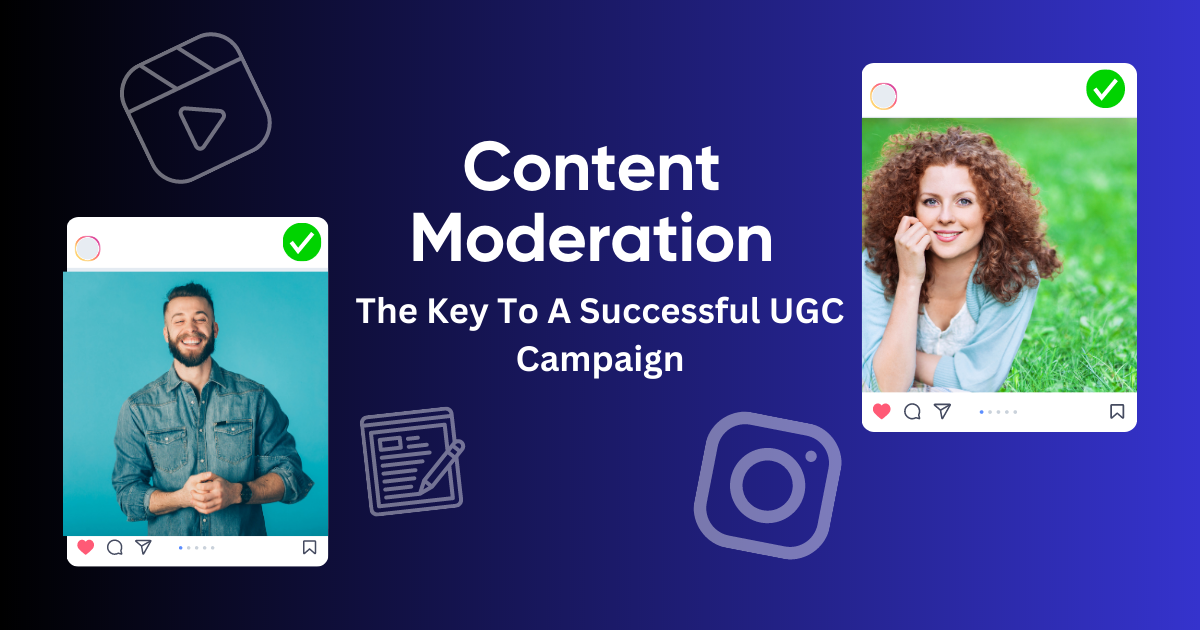Content Moderation: The Key To A Successful UGC Campaign
UGC allows brands to bond with new and potential customers based on genuine, honest reviews and visuals. Picture your mind as a well-kept library: declutter, tidy shelves. Similarly, a UGC campaign succeeds with proper attention and fitting content, like maintaining your mental space.
But there’s a challenge. The internet has a lot of opinions and feedback from people, and sometimes, they’re not true. Fake users can confuse things even more.
Here’s where content moderation comes in. It’s like having tools that sort through all the content people share, and you show your audience the content that matters and fits your brand.
Keeping every bit in mind, we have put together this blog which includes everything from simple strategies to effective social media content moderation practices to help you connect better with your potential customers.
So buckle up and get ready to read and learn why content moderation is important for your UGC campaign.

Understanding Content Moderation
Let’s start with the basics and learn the content moderation definition.
When customers submit or upload any visuals, feedback, and reviews, it goes under a screening process called content moderation. It is posted online if it passes as relevant and worthy.
Making sure your brand shines online involves careful handling of content from users. This important job, means looking closely at what users share and making sure it follows the rules.
If your brand wants to do well in the online world, it’s crucial to remove bad language, repeated stuff, and unrelated posts. Whether on social media platforms, ecommerce websites, product pages, or other online places, sticking to the rules is really important.
UGC moderation is one measure that ensures authenticity, builds the brand image, and creates an interactive and positive environment for visitors.

The Role of Content Moderation in UGC Campaigns
What is content moderation, and why is content moderation important for user-generated campaigns?
Content moderation is crucial for ensuring relevant and valuable user-generated content in UGC campaigns. It also prevents the approval of offensive material, reducing the risk of bans or blocks.
Users and brands are both responsible for submitting honest and unbiased content in the form of visuals or reviews; however, it is the role of brands to supervise it and maintain its tone and narrative; according to statistics, 55% say the primary content influencing them to make the purchase is visual content, for example a digital lookbook, and 26% goes to written content.
To expand your knowledge, read further about why content moderation is important for user-generated campaigns, strategies, and practices.
Key Benefits of content moderation of UGC Campaigns for eCommerce
Still not sure?
Here are some reasons why content moderation is important of user-generated campaigns. Give them a read.
1. Positive brand image
When users share their content online, it reflects on the brand image; hence content moderation process is essential.
It ensures that no inappropriate content gets displayed on the brand’s website or digital screens, as it could harm the company’s reputation and might push potential customers away.
2. Fosters Online Positivity
The social media content moderation process is necessary as it helps maintain a positive online environment for visitors and convert them into loyal customers.
Avoid harmful user experience that damages your user engagement.
3. Terms and conditions
When users share their content, brands must moderate it to follow the page’s legal formalities.
Effectively moderating content can avoid regulatory issues by removing anything subject to terms and conditions.
4. Promotes user engagement
Visitors and other users are likelier to participate in your UGC campaigns and website when they find engaging and relevant content.
Create communities and moderate regularly to show that no harmful content will be tolerated.
Effective Content Moderation Strategies
Content moderation aims to maintain transparency between the brand and its users, and while it varies from company to company; therefore, it is a necessary step that they should take as it eliminates prohibited content and helps boost sales.
Below are some effective content moderation strategies that brands must consider.
1. Use appropriate tools
Handling user-generated content (UGC) in a big and busy online community can be quite demanding. To make things easier, you can use tools such as Tagshop. This tool helps you gather content by looking at specific words, tags, and provides automated methods to organize it.
Use Tagshop to help you stand out with social UGC and quickly moderate your social proof to showcase it on your social media, social commerce platforms, and product pages.
Flaunt your social content on touchpoints, prioritize brand-user transparency, secure content rights for no legal repercussions, and expert analytics with valuable insights to achieve your goals with this effective content moderation tool. Not only this but make your valuable customer’s content shoppable using the UGC gallery or Shopon bio.
2. Set brand values by welcoming critical feedback
While positive reviews help elevate your business and bond with your users, negative and critical content in the form of reviews and visuals are equally important for shaping your business plan.
When visitors are still purchasing, they are interested in the truth, and only positive feedback may stand as a problem. So embrace the negative feedback posted on your website and socials as it helps you improve, connect with new visitors, and strengthen bonds with existing customers. Learning to respond effectively in professional business English to critical feedback can enhance your brand’s credibility.
3. Disclose collaborations and repurpose
As a brand, collaborating and dealing with influencer marketing experts is standard and helps the brand boost its sales and expand the business. Repurpose this content and ask the content creators to share their honest feedback.
Remember that disclosing any reviews they uploaded to your customers and followers is equally important. It helps in making better purchasing decisions.
People find the current customer’s word of mouth more reliable than the content creators, hence make that collaboration count and repurpose it by linking visuals to support their words.

4. Assign the “verified user” tag.
Sometimes if a product has all positive reviews and is glorified as the best product, readers need help to believe and may lose trust in your brand.
Source: ecomengine
So practice this tactic and ask your reviewers to become verified users. This will display a badge indicating their role and assure the visitor of its authenticity. It will also assure the reader that your business focuses on quality over quantity.
Make your user-generated content more trustworthy and your marketing game strong by being quality conscious.
5. Ask for attribute information
As necessary as it is to learn about the authenticity of the reviewer and their reviews, another piece of information to ask your purchaser about their experience is the attribute information like size and fit, quality, and comfort of the product purchased.
When people leave this detailed information, it helps your brand’s new consumers make their buying decisions precisely.
For instance, if you own a skincare brand, ask the commentator to drop information about their skin type and how the product helped them overcome their issues.
6. Be responsive and apologize if needed
The internet is a place where you can’t keep everyone happy and satisfied, and therefore you need to be responsible and make amends if needed as a great tactic to retain your customers.
Source: Burger King’s Twitter Page
Practices like responding to your customers in their feedback box and asking them how to improve will only take your company ahead of your competitors.
So focus on being responsive along with filtering content to be displayed.

User-Generated Content Moderation Best Practices
Now that you know what content moderation is and strategies to help you master it, here are some practices to remember for the future.
User-generated content comes with its powers and challenges; it can help you build your brand with authenticity or brand its image, so be careful while allowing content to be displayed online publicly.
Read the practices that will take your business to another level.
1. Combine both manual and automated moderation methods
As crucial as it is, social media content moderation is a process that can be time-consuming. Hence to avoid this, use manual and automated or AI content moderation.
Automated content requires assistance and can take time, but it can help you stop all the inappropriate content from being showcased online.
2. Define community rules
Another way to take measures to stop harmful content is to state your rules and regulations in the community guidelines, which will help people understand what not to post.
Not only that, but this way, the rater knows what information will be helpful and is allowed by the page and brand.
3. Take action on negativity.
Be quick and straightforward in your actions regarding unacceptable content posted by people online.
Stop the content from further destroying your image, connections, and others’ experience by removing it.
4. Regularly monitor your UGC campaigns
Don’t just check by thoroughly going through your UGC campaigns; this step will fasten your process of catching unwanted content before posting.
This process can be done with the help of manual and automated or AI content moderation tools.
Over to you
We hope that you have the answer to why content moderation is important for user-generated campaigns.
User-generated content can significantly help elevate your brand’s positive image and enhance the customer’s experience. It can also act as a weapon in building a strong sense of community for your brand, but it comes with hurdles that can hinder your path to achieving goals.
By now, you clearly understand the value of UGC and its effectiveness after moderating content, as it ensures no leaks which pour in uninvited negativity.
So what’s the wait for? Earn your customer’s trust by leveraging your reviews and user-generated content.











